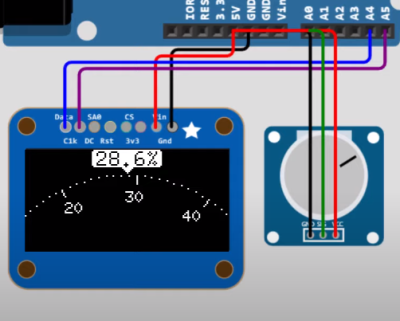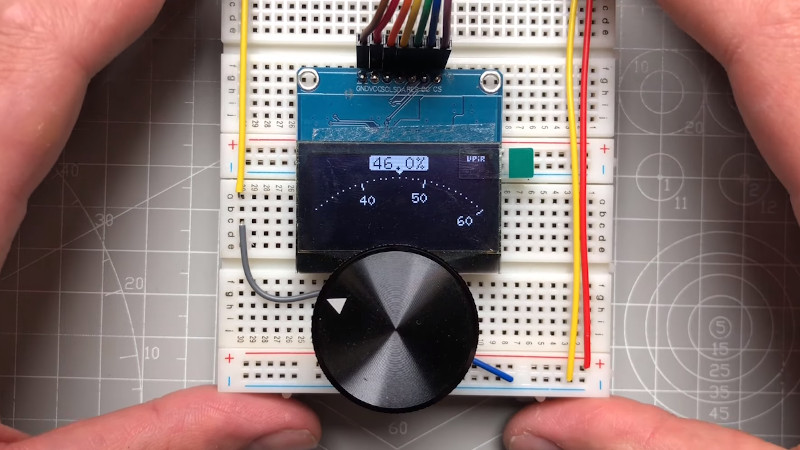As far as input devices go, the potentiometer is pretty straightforward: turn it left, turn it right, and you’ve pretty much seen all there is to see. For many applications that’s all you need, but we can certainly improve on the experience with modern technology. Enter this promising project from [upir] that pairs a common potentiometer with a cheap OLED display to make for a considerably more engaging user experience.

The basic idea is to mount the display over the potentiometer knob so you can show useful information such a label that shows what it does, and a readout of the currently detected value. But you’ll likely want to show where the knob is currently set within the range of possible values as well, and that’s where things get interesting.
In the video after the break, [upir] spends a considerable amount of time explaining the math behind details like the scrolling tick marks. The nearly 45 minute long video wraps up with some optimization, as getting the display to move along with the knob in real-time on an Arduino UNO took a bit of extra effort. The final result looks great, and promises to be a relatively cheap way to add an elegant and functional bit of flair to an otherwise basic knob.
With the code and this extensive demonstration of how it all works, adding a similar capability to your next knob-equipped gadget shouldn’t be too much of a challenge. Perhaps it could even be combined with the OLED VU meters we’ve covered previously. Be sure to let us know if you end up using this technique, as we’d love to see it in action.
Thanks to [Marko] for the tip.















Definitely a hack XD XD
I just learned that 10 turn potentiometers with counting knobs can be had for a couple dollars.
This is an amazing hack because you could switch the granularity with another button. Or simply use it with the 10 turn pot.
Search precision potentiometer or 3590s on your favorite far east distributor. Whether by the bay, or the amazon jungle or the Ali Express
I’ve picked up a few at ham fests and they were made in the US. Two adorn my Arp Odyssey where the worthless pressure pitch benders were. They now set the pitch of the 2 oscillators instead of coarse and fine slide pots that were unstable. Coarse overrode fine, what a joke. Now I can change pitch whilst playing. Turns counting dial shows where I’m at.
Make a bigger display above the tuning knob for a multi-band SW radio with a SDR behind things. Put a yellowed plastic in front of the “dial”! Might be worth it in an already gutted prewar radio cabinet. I”ve got a few. Unfortunately there whole countries that don’t broadcast now whose names wouldn’t appear across the “dial”.
A automated staging/theater equipment company I worked for in the 80s wanted an easy way for a user to specify a distance of 0 to 100 ft with a resolution of .02 feet (1/4″). We came up with essentially a rotary encoder/digital potentiometer whose granularity was a function of how fast it was turned. The knob had a little indent for your finger to facilitate fast spinning; it worked very well. I always wondered why it was never used for short wave radios. And I just now wonder why a patent was never sought.
Would love to see how you did that in the 1980’s. Lots of LS logic goodness and maybe an 8-bit CPU, I’m sure!
Digital rotary knobs with acceleration are used in, at-least, modern Amateur Radio gear. I have a uBITX v6 radio (1) with “reedbn” firmware that implements acceleration (2). I’m sure other commercial radios use it too, I just can’t think of any off the top of my head.
(1) https://www.hfsignals.com/index.php/ubitx-v6/
(2) https://github.com/reedbn/ubitxv6
At first i thought it was a encoder, not just a poti..
But both could make sense… A rotary encoder + a digital resistor would be able to switch sensitivity on the input like Miles said above…
Can’t help but think that some lookup tables would speed up the trigonometry and make it run a load faster.
The linked code does use lookup tables.
I’d not come across that IDE/simulator before, that’s cool! And it works with ESP32 boards also! That alone was worth me watching the whole video. Being able to look over someone else’s shoulder to see their development process, also cool.